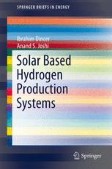Search
Search Results
-
Waste Thermal Energy Harvesting (III): Storage with Phase Change Materials
In last two chapters, both methods to harvest waste thermal energy through the conversion to electricity. In this chapter, energy storage as an...
-
Enzymatic transesterification of Calophyllum inophyllum oil by lipase immobilized on functionalized SBA-15 synthesized from low-cost precursor
Enzymatic transesterification of crude non-edible Calophyllum inophyllum oil with high level of free fatty acid (FFA) was investigated. As...

-
Asphaltene as Light-Harvesting Material in Dye-Sensitized Solar Cell
In this study asphaltene, waste hydrocarbons, and problematic constituent present in heavy oil have been investigated for its use in dye-sensitized...
-
Ionic Liquids as Solvents for Homogeneous Derivatization of Cellulose: Challenges and Opportunities
The chapter provides a comprehensive overview of the chemical derivatization of cellulose in ionic liquids (ILs). Different types of chemical...
-
Biocompatibility of Ionic Liquids with Enzymes for Biofuel Production
This chapter focuses on the application of enzyme technology in non-aqueous green solvents as ionic liquids (ILs) to transform biomass, mainly...
-
Porous Carbons for Carbon Dioxide Capture
Porous carbons play an important role in CO2 adsorption and separation due to their developed porosity, excellent stability, wide availability, and...
-
Research Methods for the Biotechnology of Lignocellulose
Biotechnology for lignocellulose conversion is developed with its research and application. During this process, the research method plays an...
-
Application and Analysis of Low-Carbon Technologies in Expo 2010 Shanghai
The use of new materials that are energy-efficient and eco-friendly has become one of the highlights of Expo 2010 Shanghai, China, as seen in the...
-
Methanol Utilisation Technologies
Oil and gas are raw materials—the availability of which is prognosticated to run short in the near future. The peak oil discussion is an example...
-
Rechargeable Batteries, Separators for
The battery industry has undergone tremendous growth over the last couple of years – both in terms of technological growth as well as in the variety...
-
Stability Studies of Immobilized Burkholderia cepacia Lipase and Its Application in Biodiesel Production from Jatropha curcas Oil
This chapter focuses mainly on biodiesel production from the “future green gold” namely Jatropha curcas. The importance of this plant as biodiesel...
-
Metal Carbides in Fuel Cell Cathode
Moderate-temperature fuel cells are clean power generators for both stationary and mobile applications. In particular, polymer electrolyte membrane...
-
Lignin: untapped biopolymers in biomass conversion technologies
Lignin is the second most abundant natural aromatic polymer after cellulose in terrestrial ecosystems. Lignins differ in structure, depending on the...

-
Biodiesel and its Blending into Fossil Diesel
This chapter examines the various unintended consequences of biodiesel production including loss of biodiversity and shortfalls in GHG reductions. An...
-
Waste Mechanical Energy Harvesting (I): Piezoelectric Effect
Mechanical energy is one of the most ubiquitous energies that can be reused in our surroundings. The sources of mechanical energy can be a vibrating...
-
Silicon-Based Anodes for Li-Ion Batteries
Silicon is environmentally benign and ubiquitous. Because of its high specific capacity, it is considered one of the most promising candidates to...
-

-

-
Solar Hydrogen Production
The common methods of hydrogen production impose many concerns regarding the decline in fossil fuel resources, CO2 emission, and ecological impacts....
-
Solar Energy
Designing a system for solar energy conversion into thermal energy or electricity is based on accurate assessment of the solar radiation in the given...
